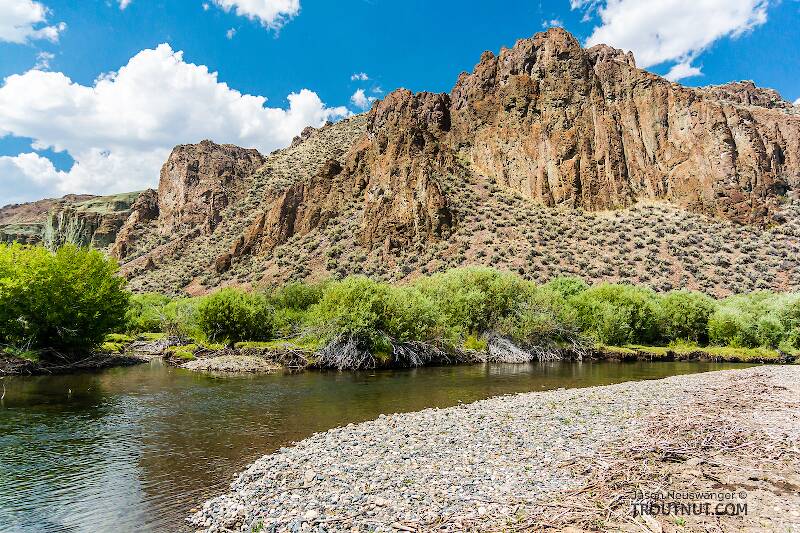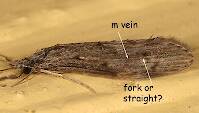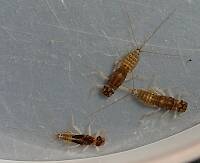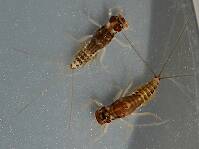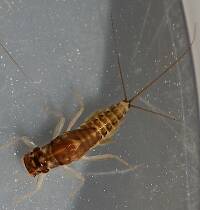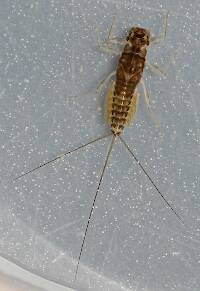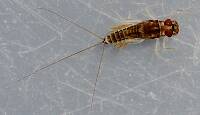
Hex Mayflies
Hexagenia limbata
The famous nocturnal Hex hatch of the Midwest (and a few other lucky locations) stirs to the surface mythically large brown trout that only touch streamers for the rest of the year.
Featured on the forum

This specimen keys pretty easily to Onocosmoecus, and it closely resembles a specimen from Alaska which caddis expert Dave Ruiter recognized as this genus. As with that specimen, the only species in the genus documented in this area is Onocosmoecus unicolor, but Dave suggested for that specimen that there might be multiple not-yet-distinguished species under the unicolor umbrella and it would be best to stick with the genus-level ID. I'm doing the same for this one.

Troutnut is a project started in 2003 by salmonid ecologist Jason "Troutnut" Neuswanger to help anglers and
fly tyers unabashedly embrace the entomological side of the sport. Learn more about Troutnut or
support the project for an enhanced experience here.
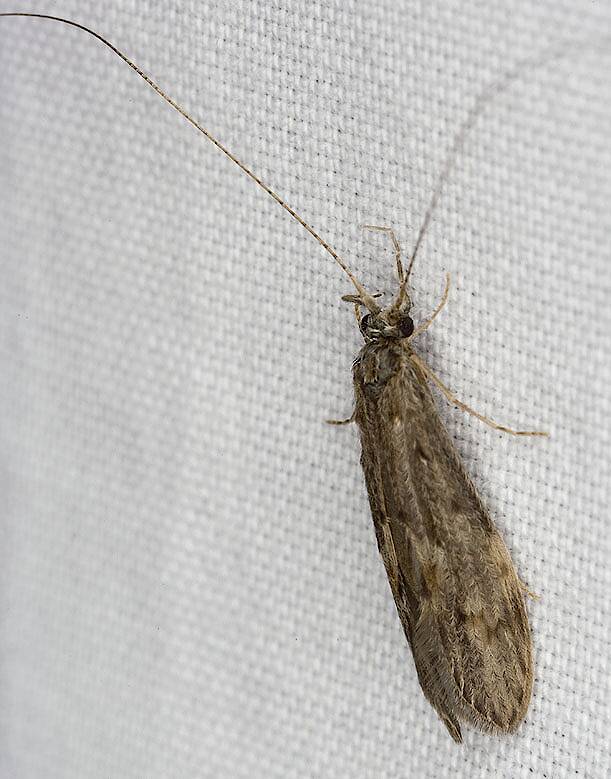

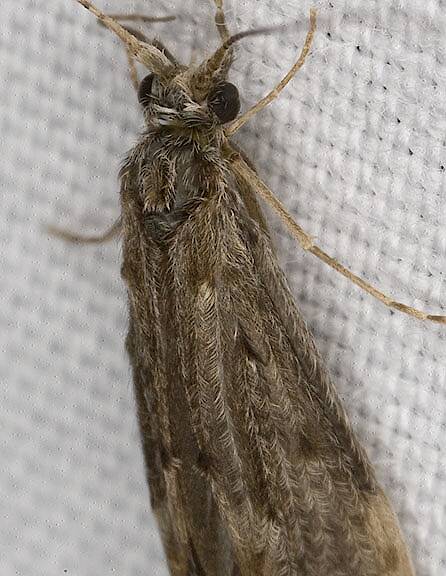

Nanz on Jun 4, 2008June 4th, 2008, 11:19 pm EDT
This caddisfly came to a UV light which I set up next to a man-made stream in a city park in Brooklyn, NY. I think it's about 9.5 mm.
Steve
Creno on Jun 5, 2008June 5th, 2008, 5:21 am EDT
It appears to be a leptocerid but I don't recognize the color pattern. Perhaps the eastern folks will be familiar with the pattern. Given the habitat and a little that I think I see from the wing this may be Oecetis.
Nanz on Jun 5, 2008June 5th, 2008, 9:54 pm EDT
Thanks. I figured it was a leptocerid. Tom Murray has a couple shots on Bugguide of what appears to be in the same genus.
Not sure if it helps, but I added a couple blow ups. What would you be looking for in the wings to help with the ID?
Not sure if it helps, but I added a couple blow ups. What would you be looking for in the wings to help with the ID?
Steve
Quillgordon on Jun 5, 2008June 5th, 2008, 11:15 pm EDT
Guys,
Leptoceridae...........
1. L.ceraclea (scaly wing sedge)
wing..... color varies from light brown to dark brown, or from light gray to almost black. On many species the wings have 'patches of white hairs and/or pockets of white scales'.
2. L.oecetis (long horned sedge)
wing..... varies from straw yellow to brown
** antenna.... may be extremely long
I would guess this is L.ceraclea based on the 'white hairs ' on the scaly wings!
Ref: Caddisflies, Lafontaine, pg.253
Leptoceridae...........
1. L.ceraclea (scaly wing sedge)
wing..... color varies from light brown to dark brown, or from light gray to almost black. On many species the wings have 'patches of white hairs and/or pockets of white scales'.
2. L.oecetis (long horned sedge)
wing..... varies from straw yellow to brown
** antenna.... may be extremely long
I would guess this is L.ceraclea based on the 'white hairs ' on the scaly wings!
Ref: Caddisflies, Lafontaine, pg.253
Flyfishing is a state of mind! .............. Q.g.
C/R........barbless
C/R........barbless
Creno on Jun 6, 2008June 6th, 2008, 2:59 pm EDT
Nanz - I am looking for the shape of the apical m vein. It is not forked in Oecetis and can be fairly obvious.
As Quillgordon says, Ceraclea usually has very hairy wings. The hairs in your photo have nearly obscured the m vein apex but I "think" it looks straight at the apex. It is just not clear enough to be sure.
I wandered through what I could find of the "leptocerids" on BugGuide and didn't see anything I would say was the same as yours, but there are a couple of other Ceraclea with the obvious white scale hairs. And, I did see what looks like a really neat, and very very rare Limnephilid. It will be good to try and track that down.
As Quillgordon says, Ceraclea usually has very hairy wings. The hairs in your photo have nearly obscured the m vein apex but I "think" it looks straight at the apex. It is just not clear enough to be sure.
I wandered through what I could find of the "leptocerids" on BugGuide and didn't see anything I would say was the same as yours, but there are a couple of other Ceraclea with the obvious white scale hairs. And, I did see what looks like a really neat, and very very rare Limnephilid. It will be good to try and track that down.
Nanz on Jun 7, 2008June 7th, 2008, 10:48 pm EDT
Thank you both very much.
I increased the resolution of the second image in hopes it would show "the shape of the apical m vein" but I am not hopeful given how hairy it is. Slightly above and to the right of the center there is a dark "M" shape. The right side of the "M" looks like a branch. I don't suppose that's what you are referring to, is it?
I also am adding one more view.
The images on Bugguide, I was talking about, can be found at http://bugguide.net/node/view/115037/bgimage and http://bugguide.net/node/view/143406/bgimage.
I'm sure any help you could give to the folks at Bugguide would be immensely appreciated.
I increased the resolution of the second image in hopes it would show "the shape of the apical m vein" but I am not hopeful given how hairy it is. Slightly above and to the right of the center there is a dark "M" shape. The right side of the "M" looks like a branch. I don't suppose that's what you are referring to, is it?
I also am adding one more view.
The images on Bugguide, I was talking about, can be found at http://bugguide.net/node/view/115037/bgimage and http://bugguide.net/node/view/143406/bgimage.
I'm sure any help you could give to the folks at Bugguide would be immensely appreciated.
Steve
Litobrancha on Aug 5, 2008August 5th, 2008, 3:35 am EDT
looks like it might be Oecetis cinerascens to me but there are few Oecetis I've never seen.
Nanz, great pics. Flip those boogers over and snap a shot of their naughty bits!
Nanz, great pics. Flip those boogers over and snap a shot of their naughty bits!
Martinlf on Aug 5, 2008August 5th, 2008, 10:03 am EDT
I knew it would get dirty with you bug guys eventually; it always does. If you do flip it over, Roger will be sure to get out his little red arrows to show us what's what. In all seriousness, great photos. --And, I'm in awe of anyone who can even begin to id caddisflies.
"He spread them a yard and a half. 'And every one that got away is this big.'"
--Fred Chappell
--Fred Chappell
Taxon on Aug 5, 2008August 5th, 2008, 1:27 pm EDT
Louis-
I highly resemble that remark.
If you do flip it over, Roger will be sure to get out his little red arrows to show us what's what.
I highly resemble that remark.
Troutnut on Aug 5, 2008August 5th, 2008, 2:41 pm EDT
Very nice photos Nanz!
Jason Neuswanger, Ph.D.
Troutnut and salmonid ecologist
Troutnut and salmonid ecologist
Quick Reply
Related Discussions
Topic
Replies
Last Reply
Re: Puzzled on this mayfly, not even confident on family
In Male Rhithrogena hageni Mayfly Spinner by Troutnut
In Male Rhithrogena hageni Mayfly Spinner by Troutnut
1
Jul 23, 2019
by Millcreek
by Millcreek
2
Jul 22, 2019
by Millcreek
by Millcreek
18
Sep 15, 2014
by Oldredbarn
by Oldredbarn
2
Sep 23, 2006
by Troutnut
by Troutnut
12
Nov 12, 2020
by Millcreek
by Millcreek

